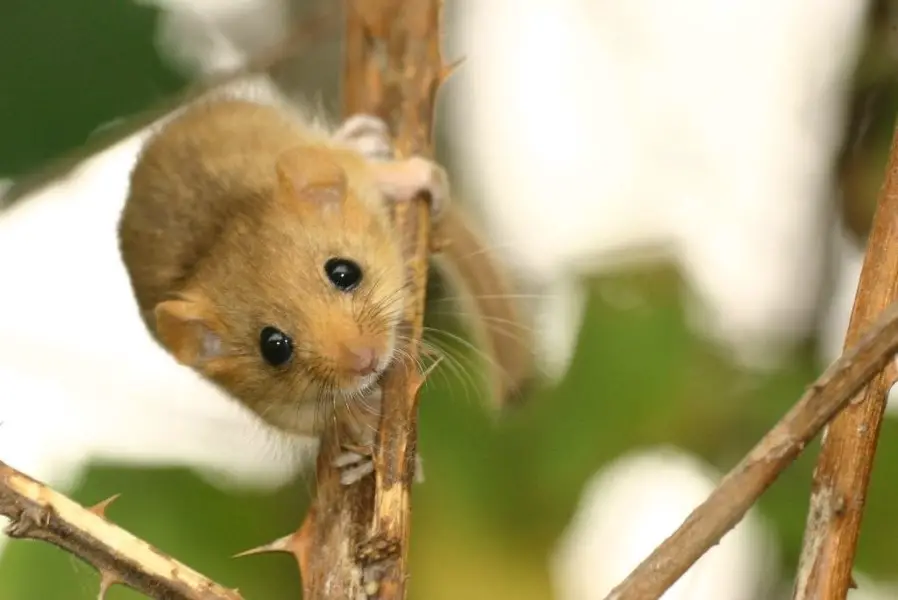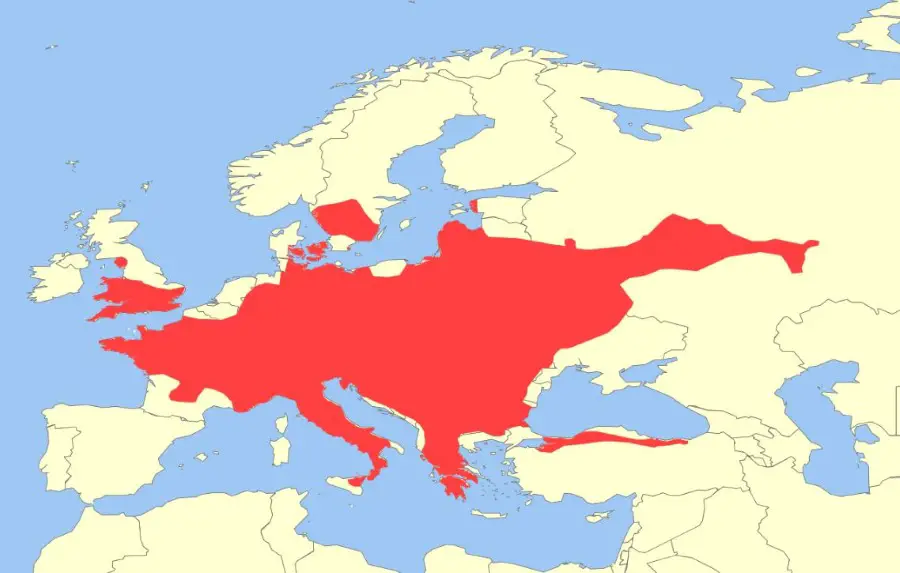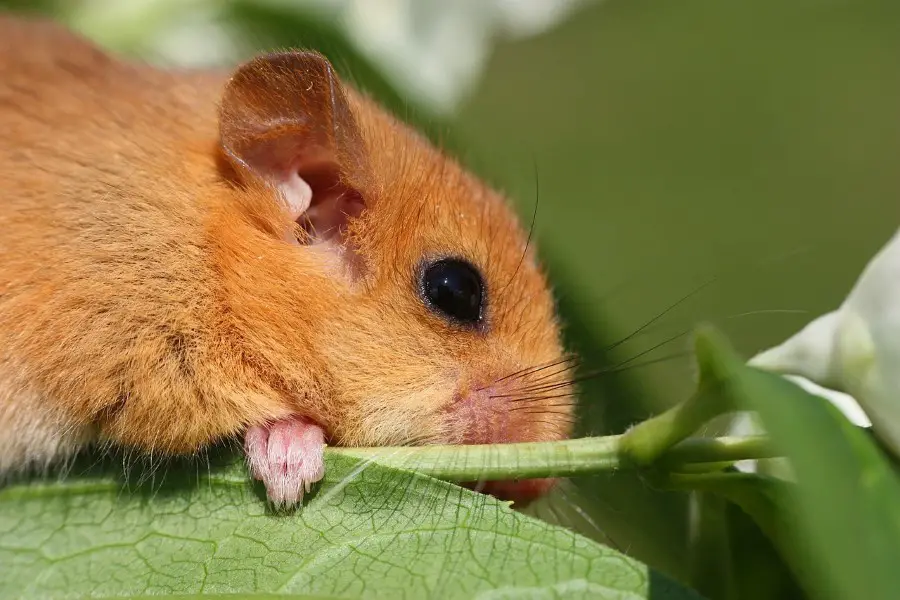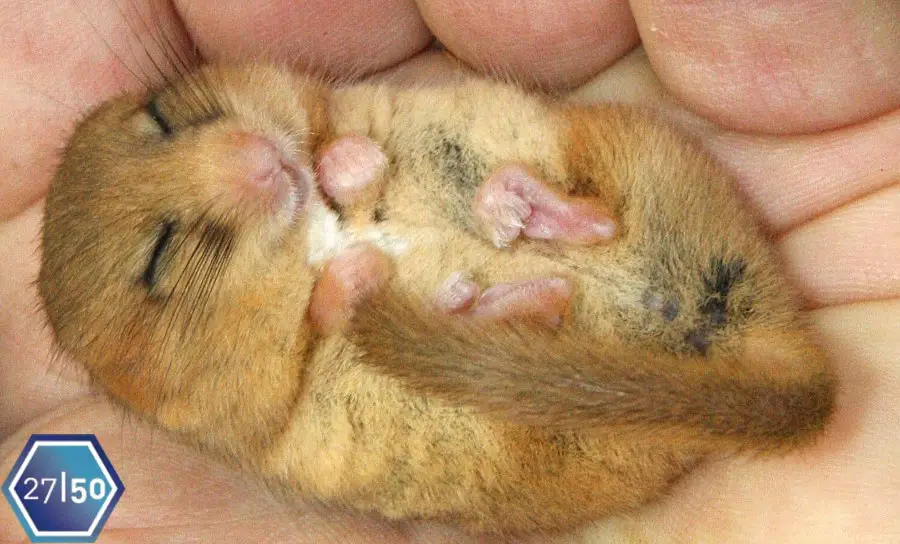In this article, we’re going to cover everything you need to know about a dormouse. habitat, conservation status, history, appearance, behavior and more. So let’s get going.
First, we’re going to start with the quick summary of what a Dormouse is, then we’ll dive into more detail about this cute little mammal!
What Is A Dormouse? Dormouse is a rodent of the family Gliridae. A small nocturnal animal, well known for long periods of hibernation that can last up to 183 days. The name dormouse comes from the word “dormeus,” which translates to “sleepy one”. Dormice belong to the same suborder of rodents as squirrels and beavers.
There are many reasons why a dormouse is different over other types of mice. This article will give you a clear insight into Britain’s sleepiest and most charming little creature.

image source: Björn Schulz[CC BY-SA 3.0], via Wikimedia Commons
Color and Appearance
A dormouse has an orange, creamy or golden fur on the top and along it’s back, with a yellow or white underside (belly) along with a white fur-lined neck.
It has a very distinctive thick, long, and fluffy tail that is sometimes white-tipped. The tail is covered in a delicate skin that can easily peel off during an attack by predators.
It has large black (rather cute looking) eyes and round ears with a chunky body. Some dormice may appear to have dark masks around their eyes, which makes it easier to spot them apart from their eponymous cousins.
A dormouse has paws that are positioned sideways which helps them to climb trees. The paws are accompanied by long grasping toes and very sharp claws
Although dormice are quite small, their perfectly structured paws, toes, and claws give them the extra ability to climb up a tree with some agility.
This comes in particularly helpful when avoiding predators or grasping favorite berries, these paws help them a lot. It also has sharp and elongated front teeth (incisors) for nibbling.
Size
A dormouse’s body (without the tail) can reach up to a length of 3.9 inches (10 centimeters). When you include the tail it can reach a length of 6.3 inches (or 16cm).
Weight
Juveniles can weigh in at 0.35-0.53 Ounces (10-15 grams). Adults weigh between 0.53-0.92 ounces (15-26 grams).
A dormouse aims to increase their body fat content before hibernation, and therefore their weight up to 1.52 ounces (43 grams) to keep them warm and provide fat reserves through Winter.
Lifespan
The lifespan of a dormouse is limited to five years and they spend most of their much of that time sleeping or hibernating. This, coupled with its nocturnal habits and the now smaller numbers, makes seeing Dormouse pretty difficult.
History (Origin and Distribution)
A dormouse belongs to the family “Gliridae” and is primarily found in continents such as Europe, Africa, and Asia.
Although dormice look like innocent tiny babies, they are one of the most ancient rodent species. Dormice fossils date back to the early Eocene, a period of 33 to 56 million years ago. During this ancient period dormice actually lived alongside ancient horses, bats and even primates.
Geography (Geographical Presence/ Expansion)
Dormice occur mainly in the southern counties and so their expansion is very much to the south.
They can be especially found in Devon, Somerset, Sussex, Cornwall, and Kent. There are records of expansion towards the localities as far up the British isles into the north Midlands area.
The Dormouse geographical expansion sets roots in parts of the country as far north as the Lake District and also throughout some scattered welsh counties too.

image source: By IUCN Red List of Threatened Species, CC BY-SA 3.0
Dormouse diet
Dormice are known as successional feeders who require a range of foods that will allow them to keep feeding on while they’re active.
A dormouse is an omnivore and has a diet that changes according to the seasons, which is quite interesting.
In spring they tend to feed on hawthorn, sycamore, flowers of oak and willow. When the season progresses, they switch to flowering shrubs such as bramble and honeysuckle.
When summer comes around, they tend to feed mostly on aphids, caterpillars, and wasp galls.
This feeding pattern during summer helps dormouse put on weight for extra warmth during hibernation. When increasing weight in time for winter, they supplement their diet by feeding on fruits and berries, such as blackberries and hazelnuts.
Another interesting fact about the feeding patterns of a dormouse is the way they feed on hazelnuts.
A dormouse feeds on a hazelnut by gnawing a round hole in the shell which leaves distinctive marks. When a dormouse feeds on a hazelnut its tooth marks run parallel to the edge of the hole instead of outwards from its center.
This makes the rim look smoother when a dormouse feeds on a hazelnut. You’ll also be able to find fewer tooth marks on the nut which makes it smoother.
This is easily identifiable, as other types of mice and voles feed through hazle nuts from outwards – to the center, making the rim look like the milled edge of a coin.
Dormouse habitat
Woodland is the primary habitat for dormice that includes deciduous and mixed woodland.
They spend most of their time among tree branches rarely choosing to make contact with the ground so they can more easily avoid predators.
Coppiced woodlands and selective felling areas are also among the ideal habitats for these small creatures.
Dormice also prefer woody vegetation. In the UK, dormice are mainly found living close to and among habitat, conifer plantations, and old hedgerows.
Dormouse nesting habits
Dormice live mostly in trees, and so they rest and raise their young in nests or old bird’s nest-box that are generally several feet above the ground.
The nests are predominantly made out of bark and leaves, built inside tree holes or brambles and hedges.
The nest is uniquely domed in shape with a measurement of 6 inches (about 15 cm) across (grapefruit-sized). A large version of the Harvest Mouse Nest.
The dormouse shreds the materials like honeysuckle barks and weaves them into a ball shape, then covers the dome with leaves.
A separate breeding nest is constructed towards June time and is much larger, lined with thistledown.
During winter, a dormouse constructs another new nest. This new nest is built on or below the ground using dead wood, leaf litter and/or moss.
A dormouse will not forage for more than 230 feet, (70 meters) from its nest. And when the weather doesn’t support them enough to find food, the dormice will remain in their nests and go into a state of “torpor” (a state of physical and mental inactivity) like a mini hibernation.
They will wake up from this state when the weather and conditions for finding food have improved.

Breeding
A dormouse has at least one litter a year but can sometimes have up to two litters a year.
The breeding seasons can be either from July to August or as early as May to June.
The litter can produce up to four young who can be weaned after about one month. But the newborn will stay with the mother as juveniles for as long as 6-8 weeks before becoming independent.
A dormouse will reach the age of sexual maturity or reproduction at the age of one year.
The newborns should also ideally reach a weight of about 0.53 to 0.63 ounces (15-18 grams) to survive the winter hibernation.
However, the success of a breed for a dormouse primarily depends on the climatic conditions as dormouse easily get affected by climatic complications. Poor weather conditions can send them into a “torpor” (short) hibernation mode.
Nocturnal animals
A dormouse is a purely nocturnal animal. Even the name for the dormouse comes from “Doremus” which means “the sleepy one”. Apart from hibernation, even during the day, they spend most of the time sleeping, which is fair why they are nocturnal animals.
Hibernation and winter effect
The dormouse hibernation period in the UK starts in November and lasts until April or even May, again depending on the weather conditions.
A dormouse goes into very long periods of hibernation that can last for a minimum of six months or sometimes even longer.
During this season they make new nests that are cozier, using piles of leaves and moss and which are generally closer to the floor to gain more moisture.
A dormouse increases it’s food intake when the winter is approaching. This enables them to double their weight and fatten up to survive the winter season. The bodyweight of a dormouse during winter can fluctuate between 0.53-1.53 ounces (15-40 grams).
Apart from hibernation, when dormice cannot find food outside due to certain conditions they tend to go to a state of “Torpor”. More like a mini hibernation, this state will reduce their body temperature helping them save energy.
So, a dormouse spends most of the time in a state of sleeping and napping. In fact, a dormouse can spend nearly three-quarters of the year in some form of sleep.
Climatic effects on dormice
Complications in the climatic conditions are also continuing to affect their breed. There are plenty of records showing the difficulties that dormice are encountering in terms of climatic changes. These include flood damage and unusually warm winters which interrupt the hibernation cycle.
To help combat the effects of flooding and other freak conditions, purposefully placing nest boxes with entrances decorated with tree trunks have been found to be attractive to Dormice, and better support their longer survival and overall successful breeding.
Solitary or colonies
Dormice live in colonies. They are a community type mammal. They prefer living among close-knit and family groups. They are more like humans, where they like to play, fight and snuggle with each other in groups, just like us.
What eats dormice?
Generally, dormice live in low dense grown vegetation and even in their ideal habitats they are not generally predated. But they can be eaten by predators such as grey squirrels, weasels, owls, and cats when they’re caught out in more open areas and active, especially during the day and especially when foraging.
In winter when they build nests very close to ground levels, they can be eaten by badgers and wild boar too. But when it comes to winter the major threat for them is not predator attack but surviving winter.

image source: flickr
Conservation status
The dormouse population is actually declining in numbers, but also declining in its range, in the UK. In fact, numbers have dropped by a third since the start of the 21st century.
As is many a sad story, habitat loss and changes in farming have been the main cause. Removal of hedgerows, trees, shrubland and field borders, as well as modern farming techniques.
In an attempt to recover the species from this decline, the People’s Trust for Endangered Species (PTES) is releasing breeding pairs within woodland habitats to try and increase the spread of the breed.
The PTES has been conducting this exercise since 1993 and now the UK has also installed appropriate arrangements as small routes, for the dormouse to cross dangerous open spaces carefully.
These apparatus include wildlife bridges and other simple arboreal structures like ropes and poles. Even complex tunnels and tubes are installed in a way that connects tree branches.
These installments also extend to purposely built green land regions, which appear as bridges covered in vegetation stretching over busy roads – providing a safe apparatus for dormice to move across or escape.
Priority species
Dormice are also recognized as a priority species in the UK biodiversity action plan and they’re protected under the wildlife and countryside act 1981.
According to law, dormice should not be intentionally killed, disturbed in their nests or nesting area, trapped, collected or even sold without a lawful license.
One of the main reasons behind such conservation endeavors is again to ensure the creature is provided with appropriate and undisturbed habitats, which features several different trees and shrubs that serve to provide food for dormice throughout the summer.
Coppice management of wood-lands has also excessively focused on creating an appropriate habitat for the sustainability of dormice. But mass cleared areas and man-made obstructions are interfering with the free movement of dormice. This is because dormice live almost exclusively in trees.
Are dormice pests?
Although an attractive creature, the dormouse cousin – the edible dormouse is considered a pest. It can cause damage and destruction to properties, crops, and tress. Simply by their presence they can cause damage in commercial, domestic and farm environments.
Can you have a dormouse as a pet?
Here’s an important point to mention first of all…
Dormice are in fact, strictly protected by law. They may not be intentionally killed, injured or disturbed in their habitats or in their nests.
They cannot be collected, trapped or sold except under strict official licenses. So it might be safer and more legal for you to get a hamster!
If you were to keep on as a pet, then Dormice can make pretty good pets. But monitoring and taking care of them can be very difficult and so may not be ideal for children. When having a dormouse as a pet many things need to be considered.
Firstly a dormouse is a social animal and so they should be kept in groups. But also too many males cannot be kept together as they can easily get into fights and cause injuries.
When it comes to moving or hand-taming dormouse it can be very difficult as they are so agile and fast and can easily escape through your hands.
We should also mention, that dormice are very good escape artists and can easily sneak through even very small openings.
A dormouse usually doesn’t enjoy being handled. For this, the best way is to make sure that any young ones are hand tamed from an early stage. A dormouse can also easily climb all over you, making them difficult to handle.
So if you want to move them to clean their habitat or similar move, then the ideal time to move them is during the mid-day when they’re asleep. When they’re asleep they are unaware of the world around them, so you can scoop them up in your hands.
The best type of housing for a dormouse is a glass tank with a tight-fitting, fine mesh top.
During their active time of the day, they will run and play around the cage and may test the boundaries. so make sure the housing structure has a secure lid to prevent them from escaping.
Similar to habitats, they also need a proper diet that includes their main groups of foods such as seed mix (mixes made for hamsters or other small rodents, with sunflower seeds or raw peanuts added are perfect), feeder insects (mealworms and crickets), cooked chicken, yoghurt, proteins such as hard-boiled eggs and even frozen fruits and vegetables.
If you keep a dormouse, it’s almost impossible to find a veterinary doctor to treat them, mainly due to legalities and just the usual difficulties in dealing with a small creature.
So if you have a dormouse as a pet, that extra care and handling are essential which may make it complicated to have a dormouse as a pet.
Also, keep in mind they are a protected species. In truth, you are not supposed to keep dormice.
Plus we’re firm believers that they should remain in their natural habitat. So if you find one, perhaps it needs nursing back to full health, fine, but then look to return it back to its native habitat.
Is a dormouse the same as a field or harvest mouse?
The harvest mouse is much smaller than a dormouse. The dormouse has an orange or yellow top with a yellow underside, whereas a harvest mouse has a pale grey or white underside with a golden-brown top.
The prehensile brown or pink tail of the harvest mouse contrasts the non-prehensile furry long tail of the dormouse. Also, the dormouse has large black prominent eyes and black whiskers.
Similarly, when it comes to the field mouse, the field mouse has a red or brown top with a pale underside …with its forelegs having an orange or brown streak in between.
Whereas the dormouse has yellow fur on the underside with orange or yellow fur on top. Most importantly the dormouse has its fury tail which the field mouse does not have.
And again the eyes and ears of the dormouse are more prominent than that of a field mouse.
Educational Resources
Don’t stop there, continue your learning at home or in the classroom with the following learning resources we’ve sourced on Amazon for you
Living with dormice
Hazel Dormouse – Everything you need to know
Educational Videos
To finish…
We hope this has been useful in understanding more about Dormice. Feel free to leave a comment below if you have any further input.
This content has been checked and verified by a qualified veterinary practitioner. The article has been reviewed by our editorial board and has been approved for publication in accordance with our editorial policy.
